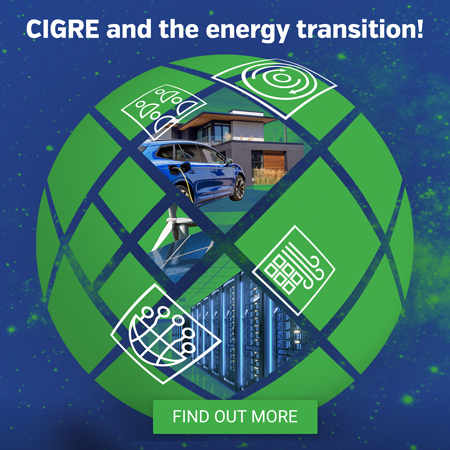Summary
2022 Grid of Future, Chicago, IL
- 2022-1 - Virtual Synchronous Generator Controller Performance and Evaluation
- 2022-2 - Resilience of Power Grids to Catastrophic Cascading Failures
- 2022-3 - Operational Security in 100% Inverter-Based Power Systems: Demonstration for Hawaii’s Big Island System
- 2022-4 - Transmission-Level Multi-Facility Coordinated Voltage Control for the Integration of Inverter-Based Resources into a Weak Grid
- 2022-5 - Substation-based Waveform Analytics Monitoring System for Improved Circuit Awareness
- 2022-6 - Protection Modeling and Dynamic Model Validation – A Real-World Case Study for Puerto Rico
- 2022-7 - Performance Testing of the Unified Grid Control Platform
- 2022-8 - Unified Grid Control Platform Concept
- 2022-9 - Constraints and Optimization in Line-Powered Fault Interrupters
- 2022-10 - Dead-Tank SF6-Free Circuit Breaker for Networks Rated 145 kV, 63 kA
- 2022-11 - Reliability of C4-FN Based Mixtures for SF6-free Distribution Switchgear in North America
- 2022-12 - Challenges to Overcoming Technology Limitations when Applying Present Day Standards to Grid of the Future (GOTF) High Voltage Circuit Breaker Applications – Capacitor Switching
- 2022-13 - Extending the Life of Overhead Aging Assets with Focus on the Energized Portion of Transmission Line
- 2022-14 - Enhancing Grid Reliability with Large-Scale Sensorless Transmission Line Monitoring – Case Study: A Year on the Line
- 2022-15 - Dynamic Line Rating Integration in Transmission Networks – Benefits and Challenges
- 2022-16 - Towards a Predictive Model for the Residual Strength of Polymer Matrix Composite Core in High Temperature Low Sag Conductors in Function of the Operating Conditions
- 2022-17 - Outage Prediction Using Fault Sensing Devices
- 2022-18 - Grid Modernization, the Feeder and Substation of the Future, and Utilizing Advanced Metering Infrastructure (AMI) as a Foundational Component of a Grid Modernization Roadmap
- 2022-19 - Increasing DER Hosting Capacity with Tie-Point Controllers
- 2022-20 - Evaluating the Impact of Tie-Point Controllers on the Distribution Grid
- 2022-21 - Detecting and Responding to Incipient Failures on Distribution Circuits
- 2022-22 - Application of Bi-Directional Converter to a Battery Backed-Up PV System
- 2022-23 - Impact of Distributed Energy Resources on Temporary Overvoltages
- 2022-24 - Improved Communication-Based Protection Schemes
- 2022-25 - Virtualization of Protection & Control – Evaluation and Deployment Considerations
- 2022-26 - ComEd’s 9 Box Method for Goose Messaging
- 2022-27 - A Precision Primary Signal Facility to Test Phasor Measurement Units
- 2022-28 - Industry Roadmap for Implementation of Distribution Synchronized Measurements
- 2022-29 - A Robust Energy System Under Uncertainty: Multi-level Optimization-based Frameworks
- 2022-30 - Probabilistic Reliability Modeling to Support System Planning
- 2022-31 - EPRI-CPLANET: Controlled Planning Expansion Tool with Corrective and Preventive Control
- 2022-32 - Enabling Distribution System to Participate in Secondary Frequency Regulation
- 2022-33 - Integrated 3D Scanning Methodologies for Improvements in Asset Upgrades
- 2022-34 - Simplified Restoration: Extending Battery Life During Station Outages
- 2022-35 - The Future of Substation Engineering – 3D BIM Design
- 2022-36 - SF6 Monitoring in the United States T&D Market
- 2022-37 - Grid Reliability: Focus on “Worst-Performing Feeders”
- 2022-38 - Impact of New Voltage Optimization Strategies on Power Distribution System
- 2022-39 - CAISO Guide to Meet 2045 California’s Renewable Portfolio Standard
- 2022-40 - Introduction to a Metrics and Validation Framework Assessing the Performance of the Distributed Energy Resource Management System Platform
- 2022-41 - RESTful Microservice Architecture for Electric Utility Distribution Systems
- 2022-42 - Building a National Infrastructure for Artificial Intelligence on the Grid
- 2022-43 - A Roadmap for the Future: Enterprise Network Model Management at TenneT, P. Brown
- 2022-44 - Cloud-Hosted Data Platform for Distribution Synchrophasor and Waveform Sensors to Drive Analytics and Applications
- 2022-45 - Virtual Synchronous Controller Based SMES/Battery Energy Storage System
- 2022-46 - Performance Evaluation Testing Protocols to Support Energy Storage Deployment in the Grid
- 2022-47 - Impact of Increasing Penetration of Distributed Energy Resources on the System Strength of Islanded Grids
- 2022-48 - Equipment Protection from Geomagnetically Induced Currents (GIC)
- 2022-49 - Flexible Interconnect Through DERMS-Learning from Practical Deployment
- 2022-50 - Data Integration, Co-Simulation, and ADMS Application Development using the Common Information Model
- 2022-51 - An Agile Approach to DERMS Implementation – Delivering Value Fast
- 2022-52 - DER Gateway to Support Real-Time Control and Situational Awareness in Distribution Grids
- 2022-53 - Distribution Battery Energy Storage System Microgrid Effective Grounding Study
- 2022-54 - Voltage-Based Method for Low-Cost, Reliable Fault Isolation in Inverter-Based Microgrids (IBR)
- 2022-55 - Real-Time Simulation of Microgrid Protection Schemes under Dominion Energy’s Locks Microgrid
- 2022-56 - Grid Modernization and System Upgrade Impacts on a Three-Wire Distribution System Serving Critical Military Loads
- 2022-57 - Accurate Calculation of VAR Demand for a Fleet of Power Transformers under the 1-in-100 years Benchmark GMD Scenario
- 2022-58 - Design Considerations in Phase-Shifting Transformers to Enhance Loadability and Controllability of the Connected Grid
- 2022-59 - Dissolved Gas Analysis: Use Case and Statistics for Advanced HVDC Application
- 2022-60 - Installation and Commissioning of Mitsubishi Electric’s MMC STATCOM (SVC-Diamond®) at Dominion Energy’s Clover & Rawlings Substations
- 2022-61 - Increasing Community Electric Vehicle Adoption with Public Electric Vehicle Charger Installations
- 2022-62 - System Impacts of an Electric Fleet Cluster on the Distribution Grid
- 2022-63 - Managed Charging Solution to Mitigate Adverse Impact of the Maximum Demand Payment Component of a Commercial Electric Vehicle Fast-charging Facility’s Electricity Bill
- 2022-64 - Planning for Fleet Electrification on Electric Distribution Systems
- 2022-65 - Optimal Volt-VAR and Frequency-Watt Inverter Settings in an Islanded Microgrid
- 2022-66 - Effective Microgrid Optimal Dispatch Settings
- 2022-67 - Interconnection and Sizing of Combined Heat & Power (CHP) in Renewable Energy Microgrids
- 2022-68 - An Economic Evaluation Framework for Sustainable Community Microgrids
- 2022-69 - Optimal Control Actions for Managing High Voltage Occurrences in Operation
- 2022-70 - An Online Electromechanical Oscillation Index for a Modern Bulk Power System
- 2022-71 - Interconnection-Wide Forced Oscillation Source Location: Method, Tool Development, and Actual Event Analysis
- 2022-72 - Improving Transfer Capability while Avoiding Series Compensation Challenges
- 2022-73 - Quantum-Assisted Contingency Analysis – Developing a Software-as-a-Service (SaaS) Tool to Reinforce the Cleantech in the Face of Climate Change
- 2022-74 - Black Swan Energy – A Story of Enhanced Climate Resilience
- 2022-75 - Commonwealth Edison Company Flood Resilience – Technology for Response
- 2022-76 - Vehicle-to-Grid (V2G) Optimal Scheduling for Grid Peak Demand Management and Emission Reduction: A State-of-the-Art Review
- 2022-77 - Real-Time Simulation Model of Network Protectors for Performance Evaluation of Secondary Distribution Networks
- 2022-78 - Using Wide-Area Precise Time Distribution to Increase Dependability and Security of Substation Time Synchronization
- 2022-79 - HYPERSIM-Based Transmission Line Protection Model for Dominion’s System Protection Technician Development Program
- 2022-80 - Transmission Line Falling Conductor Protection System Development at SDG&E
- 2022-81 - Estimating the Output of an Inclined Solar Panel Using Irradiance Data Normal to Earth’s Surface
- 2022-82 - ComEd Post-Storm Distribution Reliability and Maintenance Inspections
- 2022-83 - ComEd Resilience Metrics for Tracking Storm Restoration and Gray Sky Day Performance
- 2022-84 - Electrification Case Study in the City of Reno
- 2022-85 - Energy Storage Planning Tool (ESPT-T) Reliability and Resilience Grid Planning with Storage
- 2022-86 - Pine Grove Non-Wires Alternative (NWA)
- 2022-87 - Dynamic Non-Wires Alternatives Integration Within Distribution System Planning
- 2022-88 - Strategic Approaches to Future Grid Reliability
- 2022-89 - System Impact Assessment of a Proposed Geomagnetically-induced Current Field Test at a Dominion Energy Virginia Substation
- 2022-90 - A National Power Quality Index
- 2022-91 - Improving Customer Power Quality Leveraging AMI Data
- 2022-92 - Analysis and Application of Grid-Forming Battery Energy Storage System for Reliability Improvement on the Eversource Distribution System in Cape Cod, Massachusetts
- 2022-93 - High Reliability Alternatives to Network Systems
- 2022-94 - Controller Hardware-in-the-Loop (CHIL) Testing and Verification of Networked Microgrids
- 2022-95 - A Resilience-Driven Microgrid Interconnected Island Distribution System
- 2022-96 - Battery Energy Storage System-based Outage Management for Remote Customers
- 2022-97 - Determination of Optimal Size and Number of Movable Energy Resources for Distribution System Resilience Enhancement
- 2022-98 - Data-Driven Scalable Phase Identification in Modern Distribution Grids
- 2022-99 - Interactive Planning and Operations using Peak Load Pricing in Distribution Systems
- 2022-100 - An Iterative Control for Optimally Managing Export Limits of Distributed Generators
- 2022-101 - What’s the Rush? Can IBRs Handle Inrush Like Rotating Machines?
- 2022-102 - Improvement of Frequency Nadir and RoCoF in Puerto Rico under High IBR Scenarios by using Grid-Forming Capabilities
- 2022-103 -Real-Time Electromagnetic Transient Simulation of the Synchronization of Two Core Islands During Blackstart Procedures
- 2022-104 - EMT Model Validation of DFIG Wind Turbine Using Full-Scale Electrical System Lab Tests
- 2022-105 - Development, Design and Testing of a Retrofit Composite Insulated Cross Arm
- 2022-106 - Can a One Minute PD Test Eliminate the One-Hour Withstand Commissioning Test?
- 2022-107 - Enhanced Resiliency, Reliability, and Less Congestion with 24/7 Monitoring Platform for Aged Underground Distribution Networks
- 2022-108 - New HTS Cooling Method Can Help with Transmission Line Siting
- 2022-109 - A History of IP/MPLS in the Utility Industry and the Case for Segment Routing
- 2022-110 - Powering a Utility Scale Broadband Network Through Private LTE
- 2022-111 - Redundant Passive Optical Network (PON) Transport for Grid Intelligence
- 2022-112 - Grid Automation System Device Management and Cybersecurity
- 2022-113 - Evaluation of Smart Inverter Volt-Var Control Stability on a National Grid Distribution Feeder
- 2022-114 - A Utility Experience: Accurate CVR Energy Savings Estimation Considering Additional Cleaning Based on the Real CVR Deployment Events and Data
- 2022-115 - Performance Analysis of Machine Learning Algorithms for Conservation Voltage Reduction (CVR) Status Detection
- 2022-116 - Proof-of-Concept Studies in Machine Learning-based CVR Calculations
Additional informations
| Publication type | Colloquia |
|---|---|
| Reference | COLL_CHI_2022 |
| Publication year | |
| Publisher | CIGRE National Committee |
| Price for non member | Free |
| Price for member | Free |



